The Start.
Topic 30495 | Page 1
You've got great questions Harry. They illustrate how many parts of our industry we take for granted because we are familiar with them. Let's just start with the basic idea of being responsible for getting our job done. Truck driving is a very independent job. It is just you and the truck out here making things happen. You don't have a bunch of co-workers. I work for a very large trucking company, but there is really only one person I have much dealing with. That person is my dispatcher. It is possible you may not even meet your dispatcher in person. Your truck has a tablet in it that you will use to communicate with dispatch and record your hours of service. Here's an example of what it might look like...
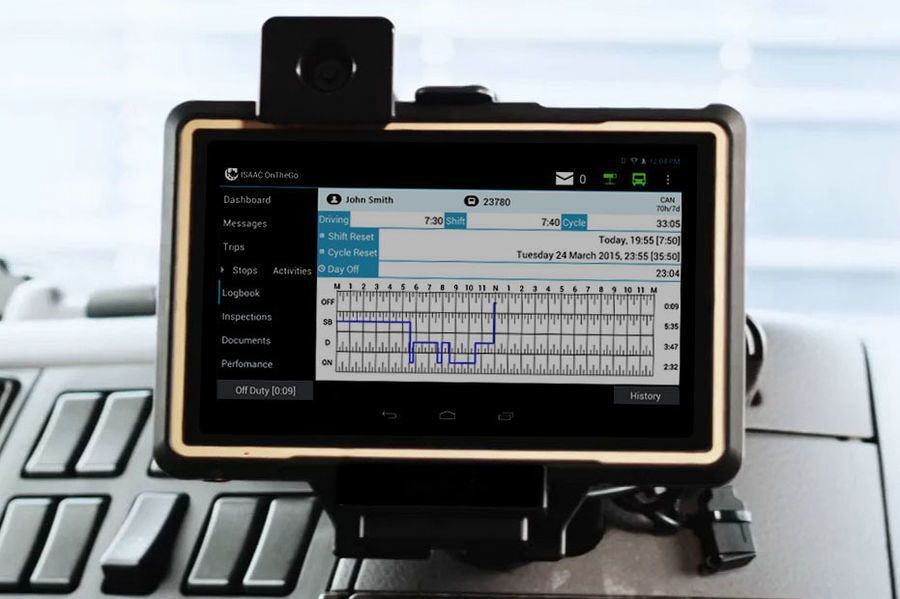
There is no set time for you to "clock in." You are in charge of how you manage your time. Let's say you and another driver from your company are each parked at a truck stop. You've both had your legally required ten hours of rest. Your dispatcher sends both of you a message at 8:30 in the morning. He needs both of you to pick up 24 pallets of dog food at a local manufacturer who is open 24 hours a day, and deliver it at 9:00 a.m. the next day to a warehouse 400 miles away. You go ahead and clock in, or put yourself "on duty," then run right over and pick up your 24 pallets of dog food. Then you proceed to drive the 400 miles to the customer. Once you get near you find yourself a truck stop and park for the night, planning on starting again in the morning so you can be there on time.
The other driver decides to wait until about midnight to put himself "on duty." Then he goes to get his pallets of dog food and drives all night (He likes driving at night). He arrives at the customer before you do, but you are both considered "on time" with your delivery. You both did it differently, but you both got the same results of being "on time." The company wants you to make on time deliveries and you both did it. Each of you worked it out the way he wanted to, and you both got good results. It doesn't really matter how much time you spent delivering the load. You both got paid for driving 400 miles.
I've met drivers who refuse to drive at night. I think it's crazy, but you asked if we get to choose our own schedule, and the answer is yes we do. Most of us choose it in such a way so that we are efficient and can get the most done. That is how you start making great money at this. You figure out ways to be more productive than your peers.
There are some truck driving jobs with minimum pay amounts no matter how much work you get done, but I can assure you that you had better be figuring our how to be productive if you want to keep that job. Truck driving is very much a competitive sport. The most productive drivers get the most work and therefore enjoy the most benefits.
I don't know of any truck drivers working for the government, but there are a few jobs like that. Most of those type jobs are contracted out to private carriers. Pensions are pretty much a financial instrument that nobody uses anymore, but most trucking companies provide a way for you to build retirement wealth through a 401K investment plan.
You can work 70 hours in an eight day period as a truck driver. That 70 hours is the combined number of "on duty" and "drive" time. You can't drive more than 11 hours per work shift. Once you take a 10 hour break you reset your 11 hour clock and your 14 hour clock. It is complicated at first, but you could start learning a lot of this stuff now by taking advantage of our free High Road CDL Training Program. It's a great educational tool that covers all the stuff you are wanting to know and a whole lot more.
CDL:
Commercial Driver's License (CDL)
A CDL is required to drive any of the following vehicles:
- Any combination of vehicles with a gross combined weight rating (GCWR) of 26,001 or more pounds, providing the gross vehicle weight rating (GVWR) of the vehicle being towed is in excess of 10,000 pounds.
- Any single vehicle with a GVWR of 26,001 or more pounds, or any such vehicle towing another not in excess of 10,000 pounds.
- Any vehicle, regardless of size, designed to transport 16 or more persons, including the driver.
- Any vehicle required by federal regulations to be placarded while transporting hazardous materials.
Dispatcher:
Dispatcher, Fleet Manager, Driver Manager
The primary person a driver communicates with at his/her company. A dispatcher can play many roles, depending on the company's structure. Dispatchers may assign freight, file requests for home time, relay messages between the driver and management, inform customer service of any delays, change appointment times, and report information to the load planners.HOS:
Hours Of Service
HOS refers to the logbook hours of service regulations.OOS:
When a violation by either a driver or company is confirmed, an out-of-service order removes either the driver or the vehicle from the roadway until the violation is corrected.
Short version to what Old School said. At 04:53 I went on duty for my pretrip inspection. I consider this punching in.
I get paid by the mile and I'm paid on dispatch.
I run my clock how the loads dictate.
As said above, there are many ways to manage you clock out here.
Most of us start OTR and are paid by the mile with various bonuses.
Good luck to you.
OTR:
Over The Road
OTR driving normally means you'll be hauling freight to various customers throughout your company's hauling region. It often entails being gone from home for two to three weeks at a time.
Here's another example. I picked up a load in Alburtis, PA going to Seagoville, TX.
Picked it up 7-9-21 and did not have enough time to leave the shipper and get to a truck stop, so I slept at the shipper. An option for this customer. The load had a dispatched miles of 1464 with a delivery scheduled for 7-13-21 at 06:30.
This load picked up in Eastern Time and delivered in Central Time. I got here yesterday and they would not take me early. So, I went to a truck stop, 15 minutes away. That was my plan. Arrived here today at 05:50 and it currently 06:14, I'm already in a door waiting to be unloaded.
I had plenty of time on this load and was able to drive it how I wanted. I drove over 600 miles on day one. Over 500 on days 2 and 3. I could have reset on this load, but because of my recaps and that on Friday I will be resetting in Joplin while I get my next student, I chose not to.
The point is we often have more than one way to run a load.
Shipper:
The customer who is shipping the freight. This is where the driver will pick up a load and then deliver it to the receiver or consignee.
HOS:
Hours Of Service
HOS refers to the logbook hours of service regulations.Harry, I thought I might break some of the basics down for you. Here's some important parts to the log book rules that may help you start to grasp the concepts of how a truck driver logs and manages his time.
HOS (hours of service) regulations determine when and how long you are allowed to drive a commercial motor vehicle (CMV). This is accomplished by placing specific limits on the number of hours you can drive or be considered on duty. The rules also specify how much time you must remain off duty before you can legally resume any driving duties. And finally, the regulations dictate when breaks are required during your workday.
There are three limits and one break requirement which must be followed at all times. They are:
- The 14-hour on-duty limit
- The 11-hour-driving limit
- The 30-minute break
- The 60/70-hour, on-duty limit
Here's how the 14 hour limit works...
This limit is usually thought of as a daily limit, even though it is not based on a 24-hour period. You are allowed a period of 14 consecutive hours of on-duty time after being off duty for 10 or more consecutive hours. The 14-consecutive-hour, on-duty period begins when you start any kind of reportable work (doing your pre-trip inspection , performing vehicle maintenance, loading / unloading cargo, fueling, driving, etc.). Once you have reached the end of this 14-consecutive-hour period, you cannot drive again until you have been off duty for another 10 consecutive hours.
Your opportunity for driving is limited to the 14 consecutive hours from the time you started your day. You can take care of other on-duty tasks beyond the 14-hour limit, but you must limit your driving time to this 14-hour window. This is a rule which has a few exceptions. There are some ways to extend this 14-hour period, but we won't get into that for this example. For now, just think of it as an important limit.
Here's an actual screen shot of a driver's daily log. It illustrates how the 14 hour rule works.
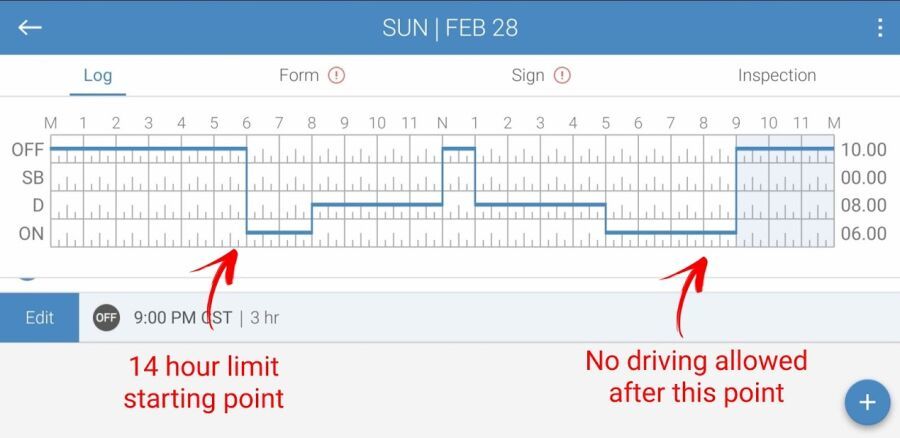
Let's try to understand the 14 hour limit by examining this driver's log. The driver began working at 6:00 a.m. (vehicle inspection, fueling, loading / unloading freight, etc.). That makes 6:00 a.m. their starting calculation point for the 14-hour, on-duty limit. They must not drive their truck after 8:00 p.m. that evening (14 hours later). They may do other work after 8:00 p.m. (load / unload freight, perform maintenance duties, etc.) but no more driving is allowed until they have taken 10 consecutive hours off duty. Once they have taken 10 consecutive hours off duty, their 14-hour limit will start over as soon as they go back on duty.
Here's how the 11 hour limit works. During the 14-consecutive-hour, on-duty period, you are only allowed to drive your truck for up to 11 total hours. Once you have driven a total of 11 hours, you have reached the driving limit and must be off duty for another 10 consecutive hours before driving your truck again. You can think of this as a window of opportunity. You have a 14-hour window of opportunity, in which you can drive your truck for 11 hours. This 11-hour driving limit is also reset when you take your 10-hour break. Both the 14-hour clock and the 11-hour clock are fully reset after logging 10 hours off duty.
Here's a driver's log showing how the 11 hour limit works.
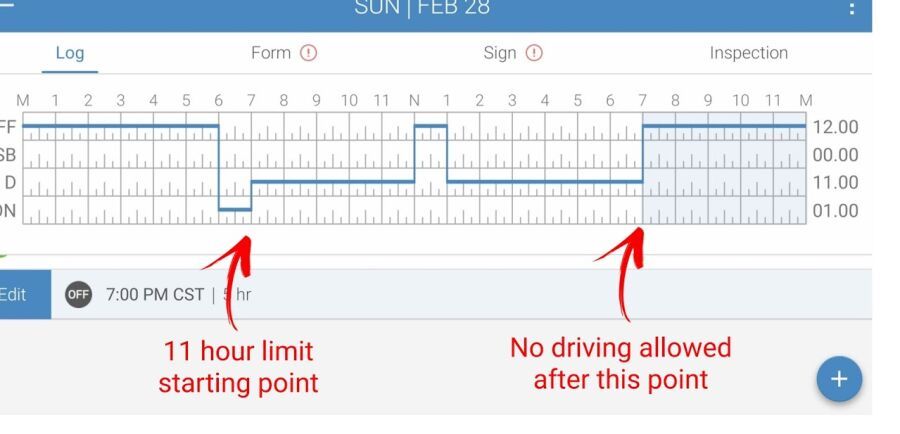
After taking 10 consecutive hours off, you begin work at 6:00 a.m. and drive from 7:00 a.m. until 7:00 p.m. with a one hour break from noon to 1:00 p.m. (total of 11 hours driving). You cannot drive again until you have accumulated at least 10 consecutive hours off duty. You may do other work after 7:00 p.m., but you cannot do any more driving of a CMV. Notice that the 11 hour limit doesn't start until you actually start driving. The 14 hour limit starts as soon as you start your on duty time for the day.
Continued...
Pre-trip Inspection:
A pre-trip inspection is a thorough inspection of the truck completed before driving for the first time each day.
Federal and state laws require that drivers inspect their vehicles. Federal and state inspectors also may inspect your vehicles. If they judge a vehicle to be unsafe, they will put it “out of service” until it is repaired.
Commercial Motor Vehicle:
A commercial motor vehicle is any vehicle used in commerce to transport passengers or property with either:
- A gross vehicle weight rating of 26,001 pounds or more
- A gross combination weight rating of 26,001 pounds or more which includes a towed unit with a gross vehicle weight rating of more than 10,000 pounds
CMV:
Commercial Motor Vehicle
A CMV is a vehicle that is used as part of a business, is involved in interstate commerce, and may fit any of these descriptions:
- Weighs 10,001 pounds or more
- Has a gross vehicle weight rating or gross combination weight rating of 10,001 pounds or more
- Is designed or used to transport 16 or more passengers (including the driver) not for compensation
- Is designed or used to transport 9 or more passengers (including the driver) for compensation
- Is transporting hazardous materials in a quantity requiring placards
HOS:
Hours Of Service
HOS refers to the logbook hours of service regulations.OWI:
Operating While Intoxicated
Here's an explanation of the thirty minute break. There are times when you will be required to take a 30-minute break. If you drive 8 consecutive hours with no breaks, you are not allowed to drive a CMV until a 30-minute break is taken. You may perform other on-duty tasks but you cannot drive. The 30-minute break can be taken as an off-duty break or it can also be satisfied during a time period of performing on-duty tasks. It can also be taken as a combination of on-duty and off-duty time. It could also be satisfied in the sleeper berth. Any combination of the three could suffice for a legal break. You could take 15 minutes on duty time fueling, then another 15 minutes off duty to run into the truck stop to relieve your bladder and purchase a snack and a drink. That would legally suffice for your 30-minute break.
If you take some on-duty time at the beginning of your shift it does not count against your eight hours drive time. You could start your day at 4:00 a.m. getting your truck loaded, and not start driving until 8:00 a.m. If that is the case you can drive for up to 8 hours (or until 4:00 p.m.) before being required to stop and take your 30-minute break. Of course, you can take it earlier if you choose. This is just an example to help you understand the structure of the rule. You simply are not allowed more than 8 hours of driving without taking a 30-minute break. Here is an example of the 30-minute break provision:
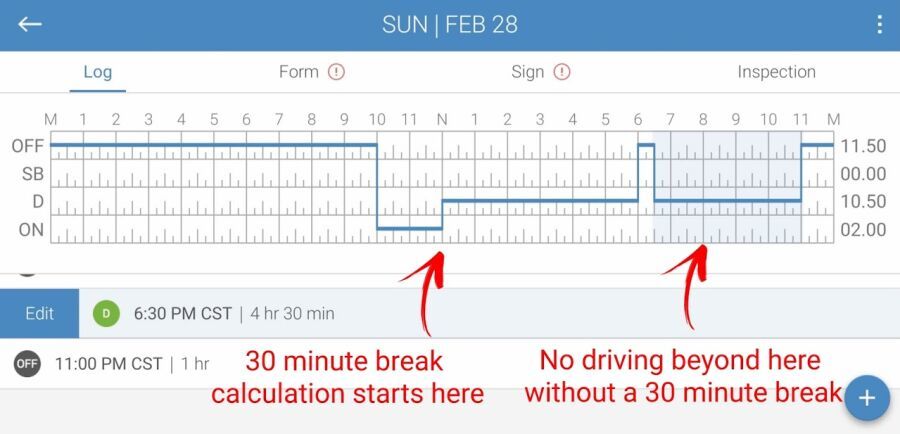
In the above example, the driver first went on duty at 10:00 a.m. That is not the starting point of his calculation for his 30-minute break. He started driving at noon. That becomes the starting point for calculating when he needs to take his 30-minute break. If the driver doesn’t stop for the next 8 hours he must take at least a 30-minute break by 8:00 p.m. (8 hours later) in order to continue driving a CMV. If a break is not completed by 8:00 p.m., no driving can legally be done. The driver can perform other on-duty tasks, but cannot drive. In this example, however, a 30-minute, off-duty break was taken from 6:00 p.m. to 6:30 p.m. so the driver was legally allowed to continue driving.
I will spare you the details on the 60/70 hour limits for now. We can drive 70 hours in an eight day period. That is the basic part you need to understand. I got way deeper into the weeds on this than I intended, but hopefully it will help you and others begin to understand how the rules work.
Sleeper Berth:
The portion of the tractor behind the seats which acts as the "living space" for the driver. It generally contains a bed (or bunk beds), cabinets, lights, temperature control knobs, and 12 volt plugs for power.
CMV:
Commercial Motor Vehicle
A CMV is a vehicle that is used as part of a business, is involved in interstate commerce, and may fit any of these descriptions:
- Weighs 10,001 pounds or more
- Has a gross vehicle weight rating or gross combination weight rating of 10,001 pounds or more
- Is designed or used to transport 16 or more passengers (including the driver) not for compensation
- Is designed or used to transport 9 or more passengers (including the driver) for compensation
- Is transporting hazardous materials in a quantity requiring placards
OOS:
When a violation by either a driver or company is confirmed, an out-of-service order removes either the driver or the vehicle from the roadway until the violation is corrected.
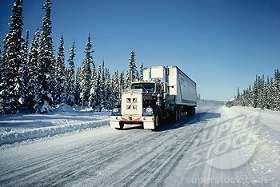
Thank you OS! That really help! So, do you guys have quotas to meet like how many loads to do in a day? The more loads or the more miles you do, the more you get paid? I really like the flexibility of it but when you're on the road it seems like its more of the country side, are there groceries near by? I know one of my friend, even tho he's always in the city he have a hard time finding toilets for some reason lol. Do you guys have that problem too?
Thank you OS! That really help! So, do you guys have quotas to meet like how many loads to do in a day? The more loads or the more miles you do, the more you get paid? I really like the flexibility of it but when you're on the road it seems like its more of the country side, are there groceries near by? I know one of my friend, even tho he's always in the city he have a hard time finding toilets for some reason lol. Do you guys have that problem too?
It depends on the type of driving you do. If you are OTR , then you can take food on the truck with you and heat it up or fully cook it. Or you can eat at truck stops (yuck). The local guys will have to talk about how to eat on the road.
Also, there are truck stops and rest areas that you can pull into to use the bathroom facilities. If you have an emergency, there are ways to take care of that also.
You are putting the cart before the horse, but when you are in training and for the first year or so, you should be doing long haul or dedicated over the road. So then you have a load that may take from 1 to 4 days to pick up and deliver it. Then after your year driving you may want to go into local or pull doubles , tankers, etcetera...they will have their own time frames. Even with over the road , you may have a load that has one or two pickups at different places and two or more deliveries at different places. For example, I will pick up in Idaho on Thursday and deliver in Greensboro NC Monday morning. I will more than likely go down to Mount Olive NC and pick up a load late on Monday or Tuesday. Then I will deliver it Thursday in Wisconsin. I will pick up in Wisconsin or Northern Illinois on Friday and that's where it varies for me. I may go straight to Idaho or I may have a 2 dropper, one in Denver and 1 in Ogden Utah. Then I run home empty to do it all over again.
Trucking has too many variables to be routine.
Laura
OTR:
Over The Road
OTR driving normally means you'll be hauling freight to various customers throughout your company's hauling region. It often entails being gone from home for two to three weeks at a time.
Over The Road:
Over The Road
OTR driving normally means you'll be hauling freight to various customers throughout your company's hauling region. It often entails being gone from home for two to three weeks at a time.
Doubles:
Refers to pulling two trailers at the same time, otherwise known as "pups" or "pup trailers" because they're only about 28 feet long. However there are some states that allow doubles that are each 48 feet in length.
New Reply:
New! Check out our help videos for a better understanding of our forum features

















Preview:








 TT On Facebook
TT On Facebook
Hey guys, I'm so used to working at a job where I clock in and clock out. But I'm confused with how this industry work. I know some companies pay by the hour, miles or both. Do they pay salary like the NBA players where it's like a fixed rate as well? Doesn't matter how much you work, you're still gonna get paid, even if you're off too if that makes sense.
How do you clock in and clock out? Are there pensions? Do truck drivers work for the government? Are they exempt from anything? Do you get to choose your own schedule? Like at my jobs before, we work until it gets done even if its 10 hrs. And then my previous job at Amazon, I work 4 hrs, if it's slow they tell us to go home or to stay if want, but once our shifts is up, another shift take over even if we don't finish. I know amazon drivers does the same thing. But how about the truck driving? Is there a team that goes out to help each other or just each person get their own route?
I heard about the 14 hr rule, I think we could be clocked in for 11 hrs max via driving but we could continue to work until 14 minus the driving, not sure how that works. Is that free 3 hours? How does the 14 hour clock rule works? I know I'm asking a lot of stupid questions, forgive me. Cause there's people on the FB group that just laugh and doesnt really give me an answer. I don't want to jump into something I have no idea how it works and just confused.
This is all foreign to me, very new. I don't want to take advantage of when I get out there. Thanks!
OOS:
When a violation by either a driver or company is confirmed, an out-of-service order removes either the driver or the vehicle from the roadway until the violation is corrected.